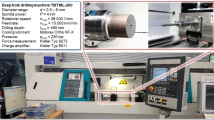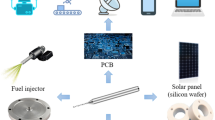Abstract
Recent trends of downsizing and miniaturization of components, e.g. in the automotive industry for the manufacturing of fuel injectors or in the medical industry for the production of bone screws or surgical instruments, increase the importance of mechanical deep hole drilling with small diameters. Unfortunately, there are still some open challenges regarding this process. In addition to the unfavorable ratio of the cutting edge rounding to the achievable feed rates and undeformed chip thicknesses which results in significant mechanical tool loads, the control of the chip formation and the removal constitutes a major difficulty. The slender tool dimensions, especially the small cross sections of the chip flutes, necessitate a favorable chip formation to achieve the required process safety and productivity. Therefore, analyses of the chip formation, when machining difficult-to-cut materials provide the means for an effective process design. This analysis, however, is particularly difficult due to the closed operating zone. Quick-stop devices used for the chip formation analyses so far are limited in the tool diameter respectively the revolution speed. Furthermore the informative value is limited, because a quick-stop test takes a significant time to stop and thus the instantaneous cutting conditions during the tool retraction are altered. To overcome these restrictions, a new method for the analysis of the chip formation in small diameter deep hole drilling is presented in this paper. It is based on the utilization of a high-speed camera and tailored material samples. The experimental set-up and the results of first analyses conducted under minimum quantity lubrication are presented. The chip formation process is analyzed for the single-lip gun drilling of the nickel-based alloy Inconel718 and the bainitic steel 20MnCrMo7.








Similar content being viewed by others
References
VDI3208: Deep-hole drilling with gun drills, 2014
VDI3210: Deep-hole drilling, Part 1, 2006
Sakuma K, Taguchi K, Katsuki A, Takeyama H (1981) Self-guiding action of deep-hole-drilling tools. Ann CIRP 30(1):311–315
Weule H et al (2004) International state of the art of micro production engineering. Prod Eng Res Dev 11(1):29–36
Zabel A, Heilmann M (2012) Deep hole drilling using tools with small diameter—process analysis and process design. Ann CIRP 61(1):111–114
Bomont-Azur A, Confente M (2007) Influenceof material structure on deep hole machinability of super high strength steels: application to crankshaft manufacturing. Int J Mach Mach Mater 2(2):282–298
Lemken T, et al. (2008) Stahl–ein Werkstoff mit Innovationspotenzial. Wuppertal Institut für Klima, Umwelt, Energie GmbH, Wuppertal
Eckstein M (2008) Überwachung und Reglung des Tiefbohrens an höchstbelasteten Komponenten von Flugzeugturbinen. VDI-Berichte Nr. 2045
Imran M, Mativenga PT, Kannan S, Novovic D (2008) An experimental investigation of deep-hole micro drilling capability for a nickel-based superalloy. J Eng Manuf 222:1589–1596
Imran M, Mativenga PT, Gholinia A, Withers PJ (2011) Evaluation of surface integrity in micro drilling process for nickel-based superalloy. Int J Adv Manuf Technol 55:465–476
Imran M, Mativenga PT, Gholinia A, Withers PJ (2014) Comparison of tool wear mechanisms and surface integrity for dry and wet micro-drilling of nickel-base super alloys. Int J Mach Tools Manuf 76:49–60
Okasha MM, Mativenga PT, Driver N, Li L (2010) Sequential laser and mechanical micro-drilling of Ni superalloy for aerospace application. Ann CIRP 59:199–202
Okasha MM (2011) Combined laser and mechanical micro drilling of nickel-based superalloy. University of Manchester, Thesis
Albrecht P (1960) New developments in the theory of the metal-cutting process: part I. The ploughing process in metal cutting. J Manuf Sci Eng 82(4):348–357
Heisel U, Stortchak M, Eisseler R (2003) Determination of cutting parameters in deep hole drilling with single-fluted gun drills of smallest diameters. Prod Eng Res Dev 10(1):51–54
Heilmann M (2012) Tiefbohren mit kleinen Durchmessern durch mechanische und thermische Verfahren. Dissertation, Technische Universität Dortmund
Fink PG (1977) Spanbildung und Bohrungsqualität beim Tiefbohren. Dissertation, Universität Stuttgart
Fuß H (1986) Aspekte zur Beeinflussung der Qualität von BTA-Tiefbohrungen. Dissertation, Universität Dortmund
Griffiths BJ (1986) The development of a quick-stop device for use in metal cutting hole manufacturing processes. Int J Mach Tool Des Res 26(2):191–203
Koehler W (2008) Analysis of the high performance drilling process: influence of shape and and profile of the cutting edge of twist drills. J Manuf Sci Eng 130:5
Smolenicki D, Boos J, Kuster F, Wegener K (2012) Analysis of the chip formation of bainitic steel in drilling processes. Proced CIRP 1:683–684
Weinert K, Adams FJ (1993) Vorrichtung zur Untersuchung der Spanbildung beim Bohren. wt Werkstatttechnik 83(2):S38–S40
Weinert K, Koehler W, Opalla D (2002) Schnittunterbrechung beim Bohren mit hohen Geschwindigkeiten. wt Werkstatttechnik 92(4):S176–S178
Ackroyd B, Chandrasekar S, Compton WD (2000) High speed photographic study of the tool-chip interface in machining. Thinning Films Tribol Interfaces 38:473–484
Sutter G (2005) Chip geometries during high-speed machining for orthogonal cutting conditions. Int J Mach Tools Manuf 45:719–726
Pujana J, Arrazola PJ, Villar JA (2008) In-process high-speed photography applied to orthogonal turning. J Mater Process Technol 202:475–485
Klocke F, Vogtel P, Gierlings S, Lung D, Veselovac D (2013) Broaching of Inconel718 with cemented carbide. Prod Eng Res Dev 7:593–600
Author information
Authors and Affiliations
Corresponding author
Electronic supplementary material
Below is the link to the electronic supplementary material.
Supplementary material 1 (MPG 50727 kb)
Supplementary material 2 (MPG 8623 kb)
Rights and permissions
About this article
Cite this article
Biermann, D., Kirschner, M. & Eberhardt, D. A novel method for chip formation analyses in deep hole drilling with small diameters. Prod. Eng. Res. Devel. 8, 491–497 (2014). https://doi.org/10.1007/s11740-014-0566-7
Received:
Accepted:
Published:
Issue Date:
DOI: https://doi.org/10.1007/s11740-014-0566-7




